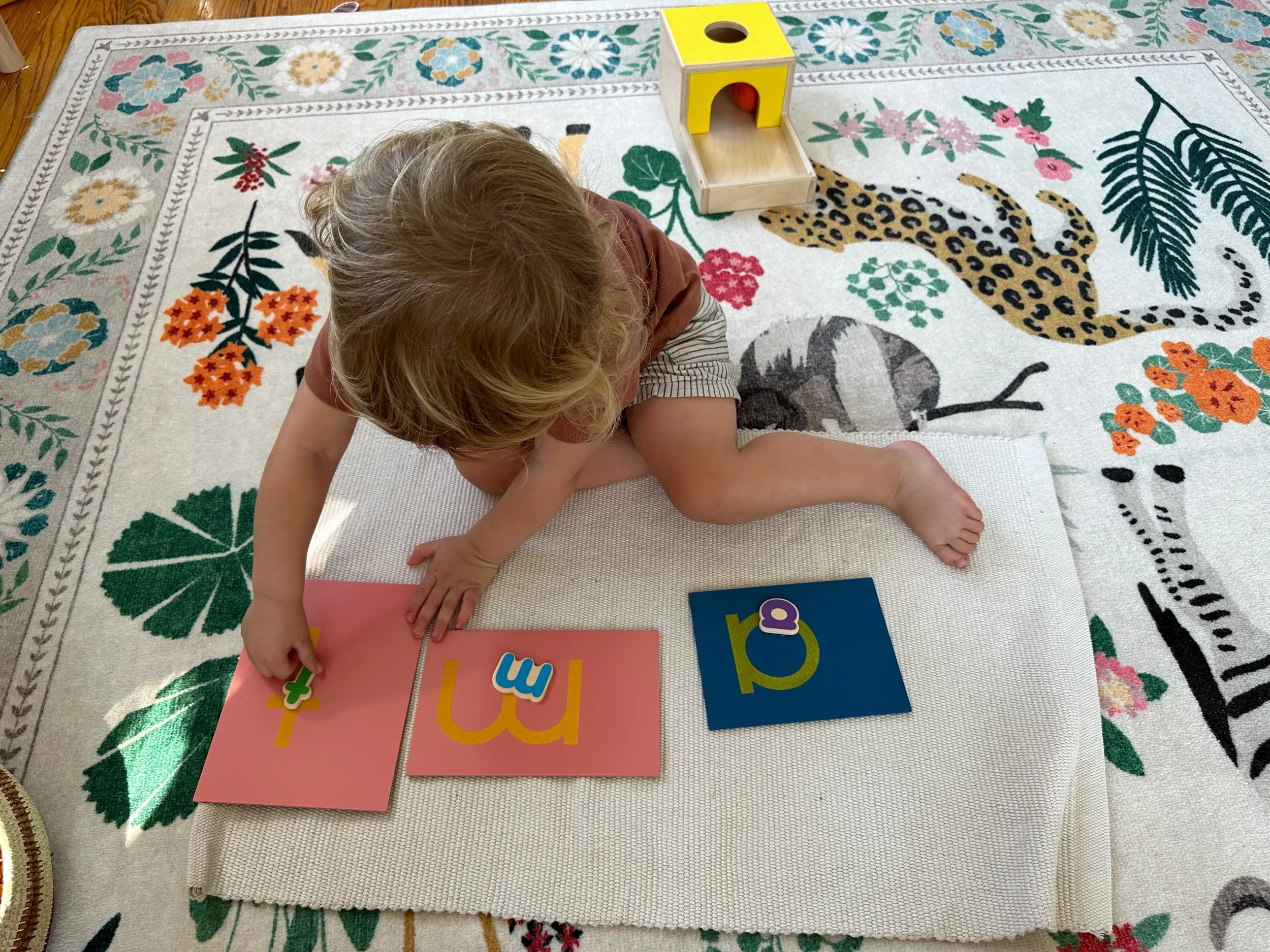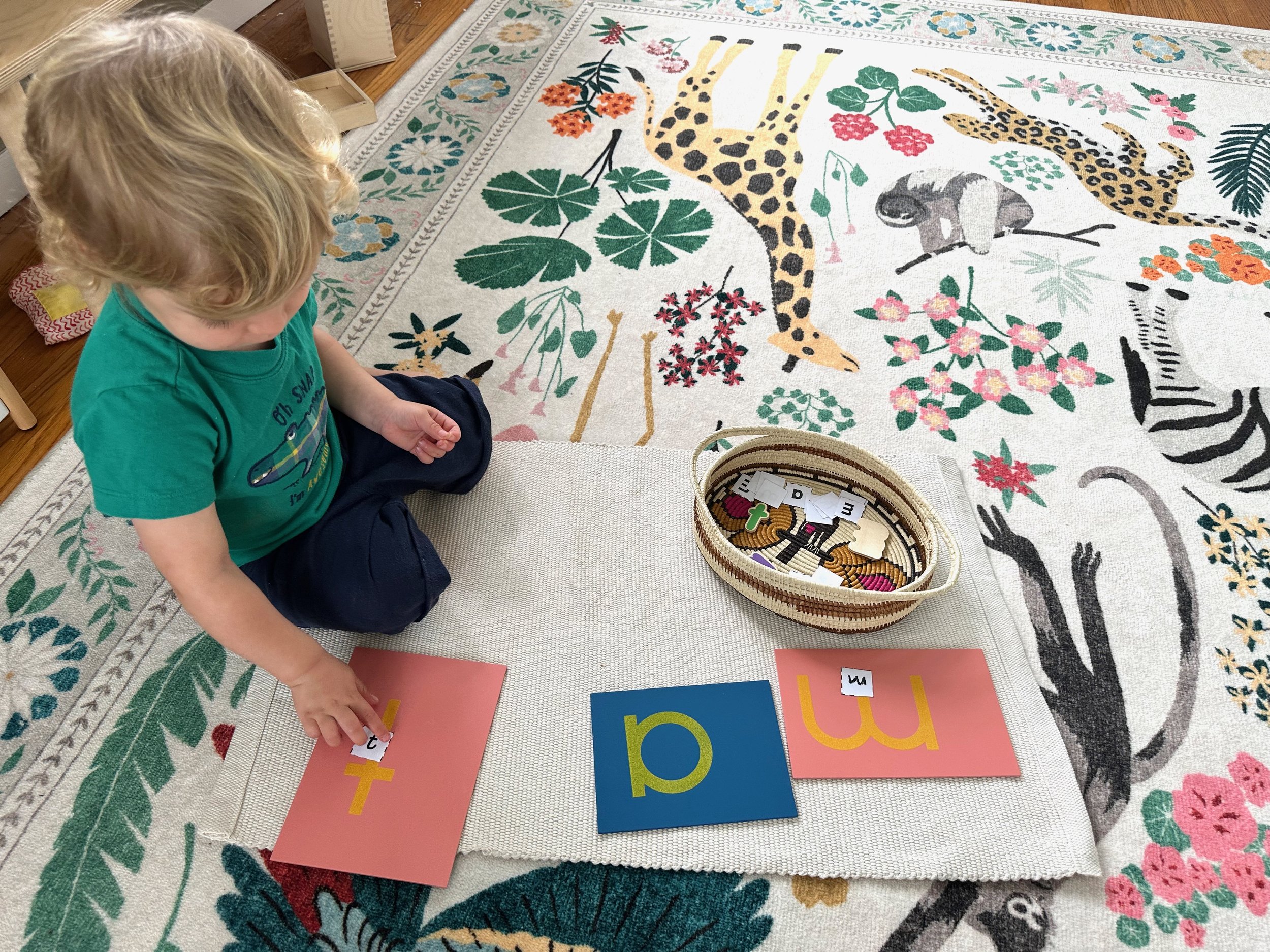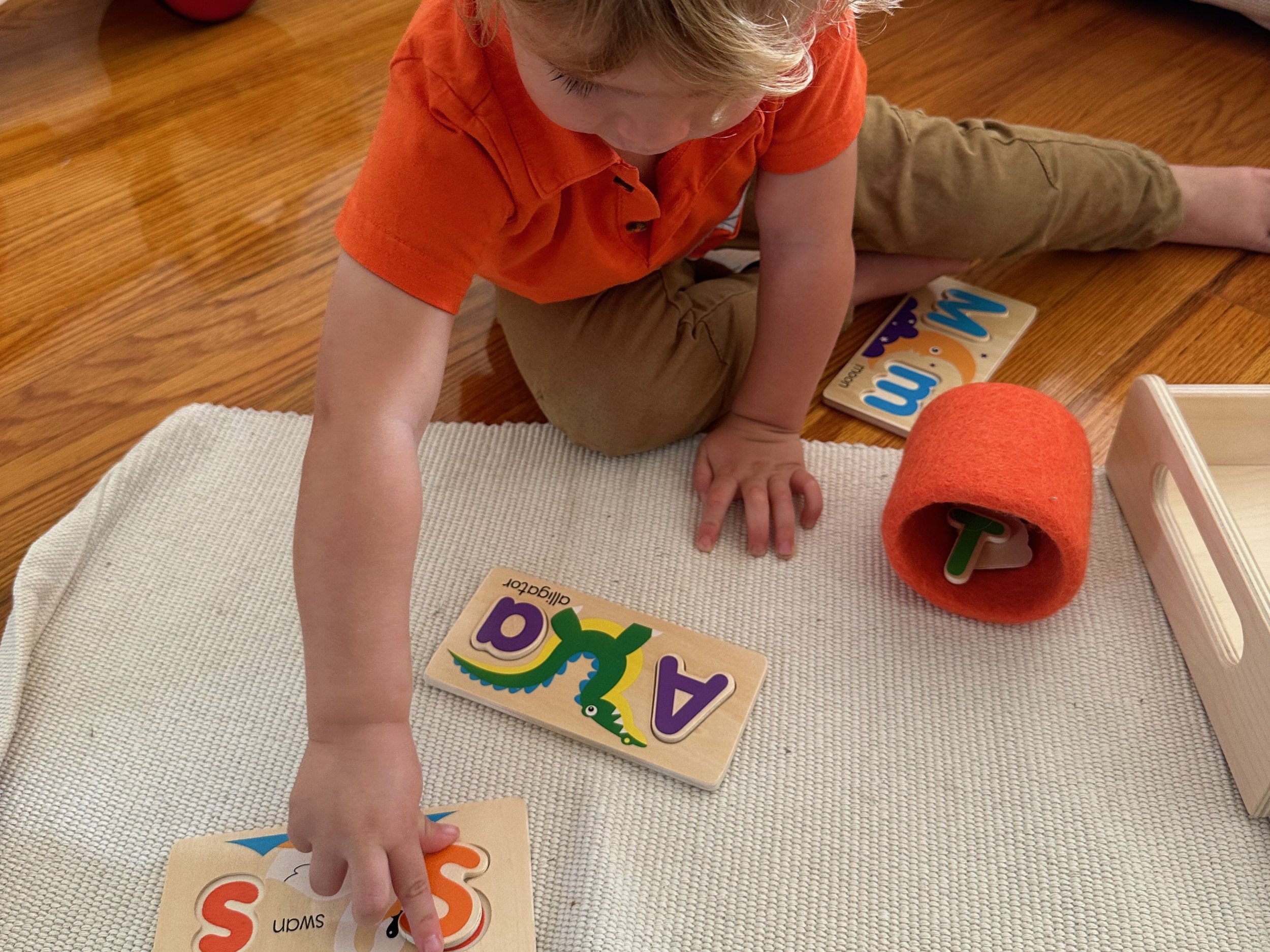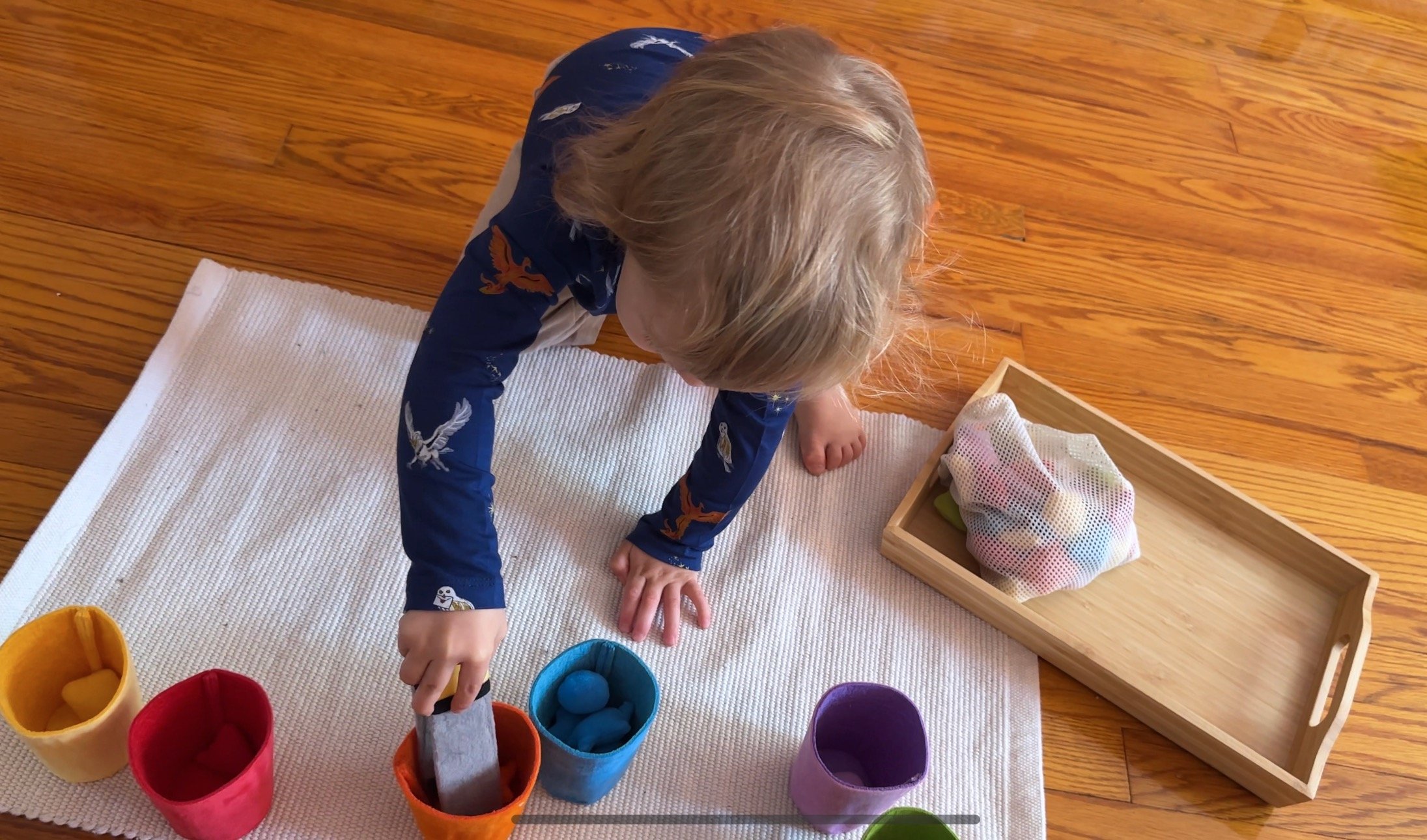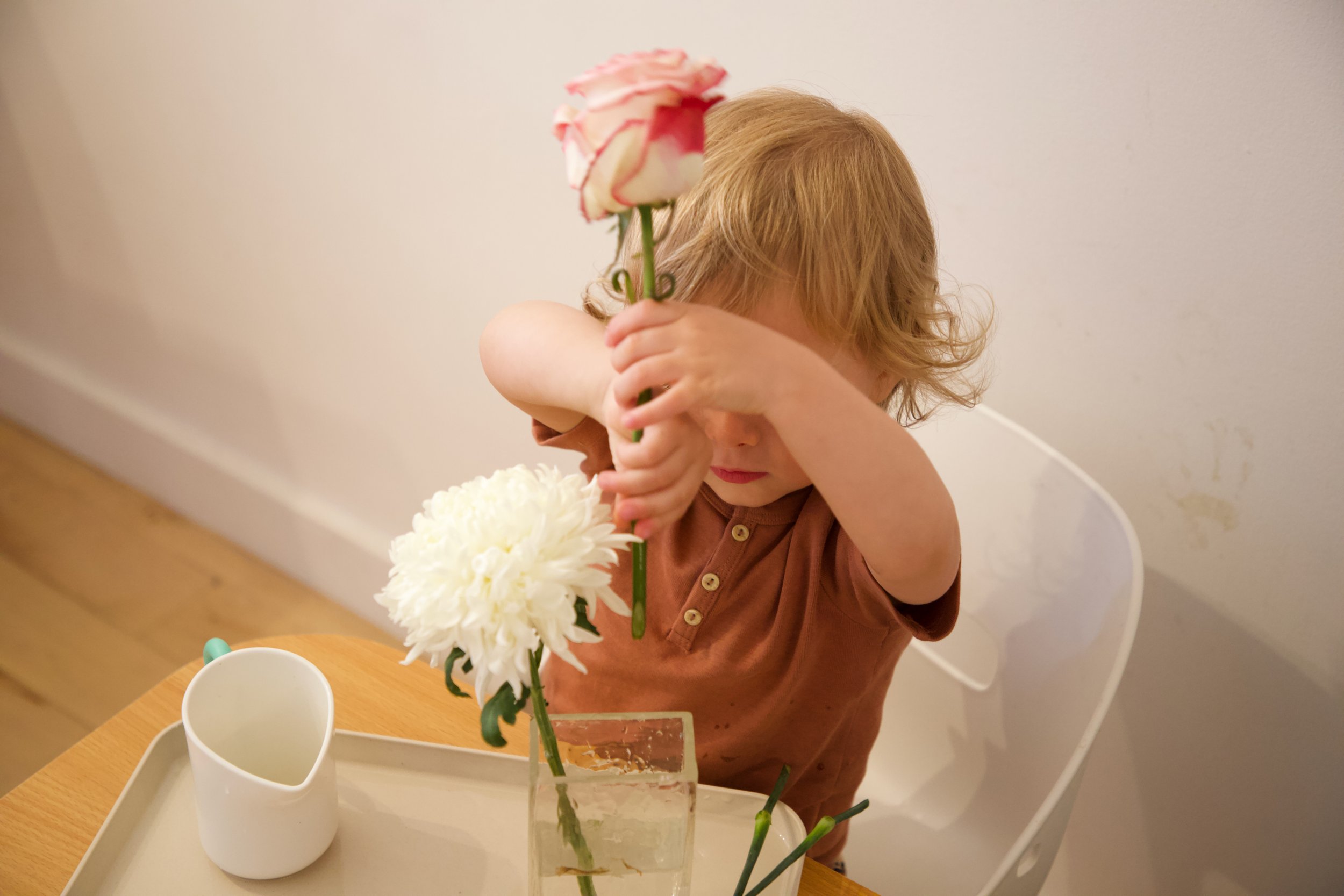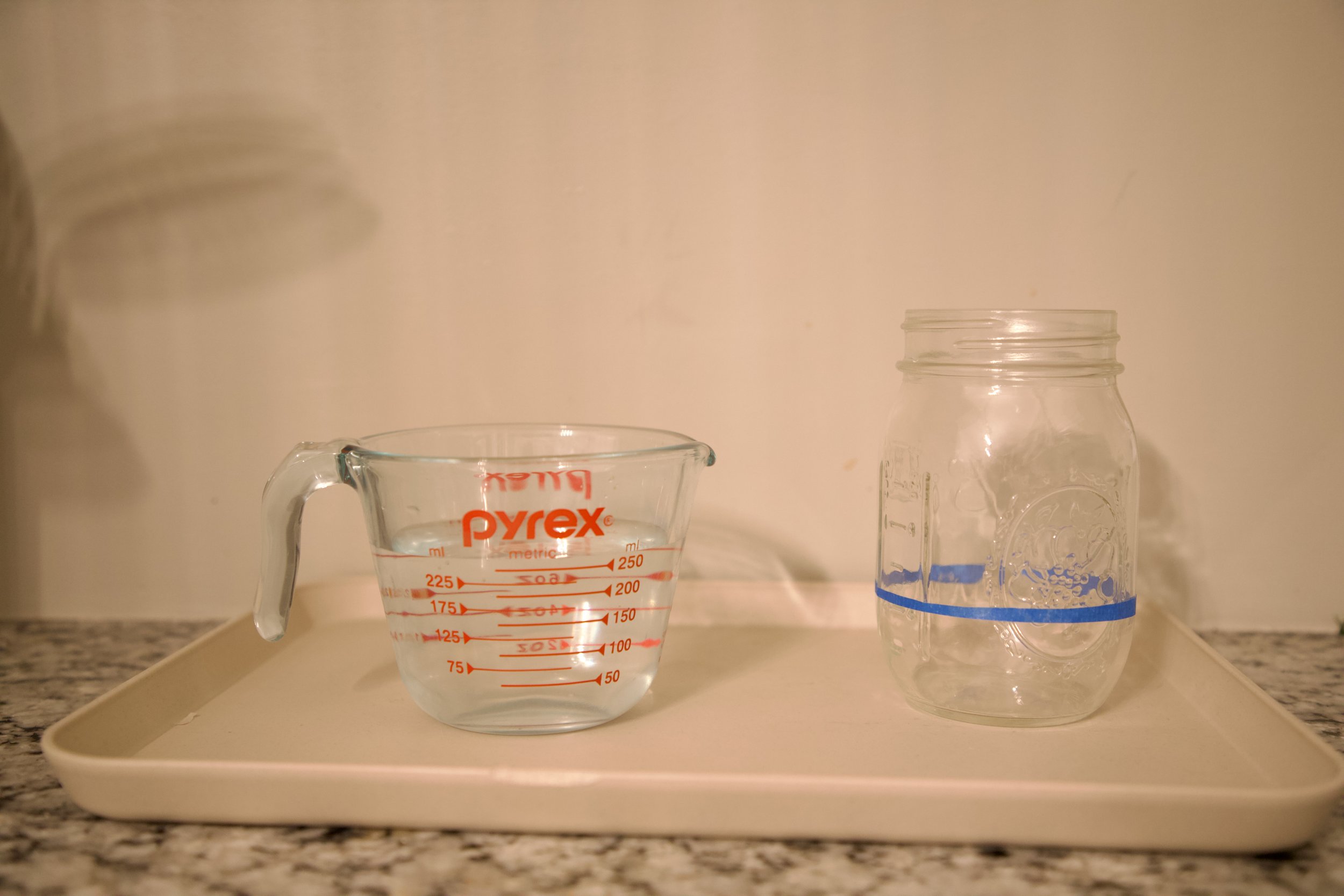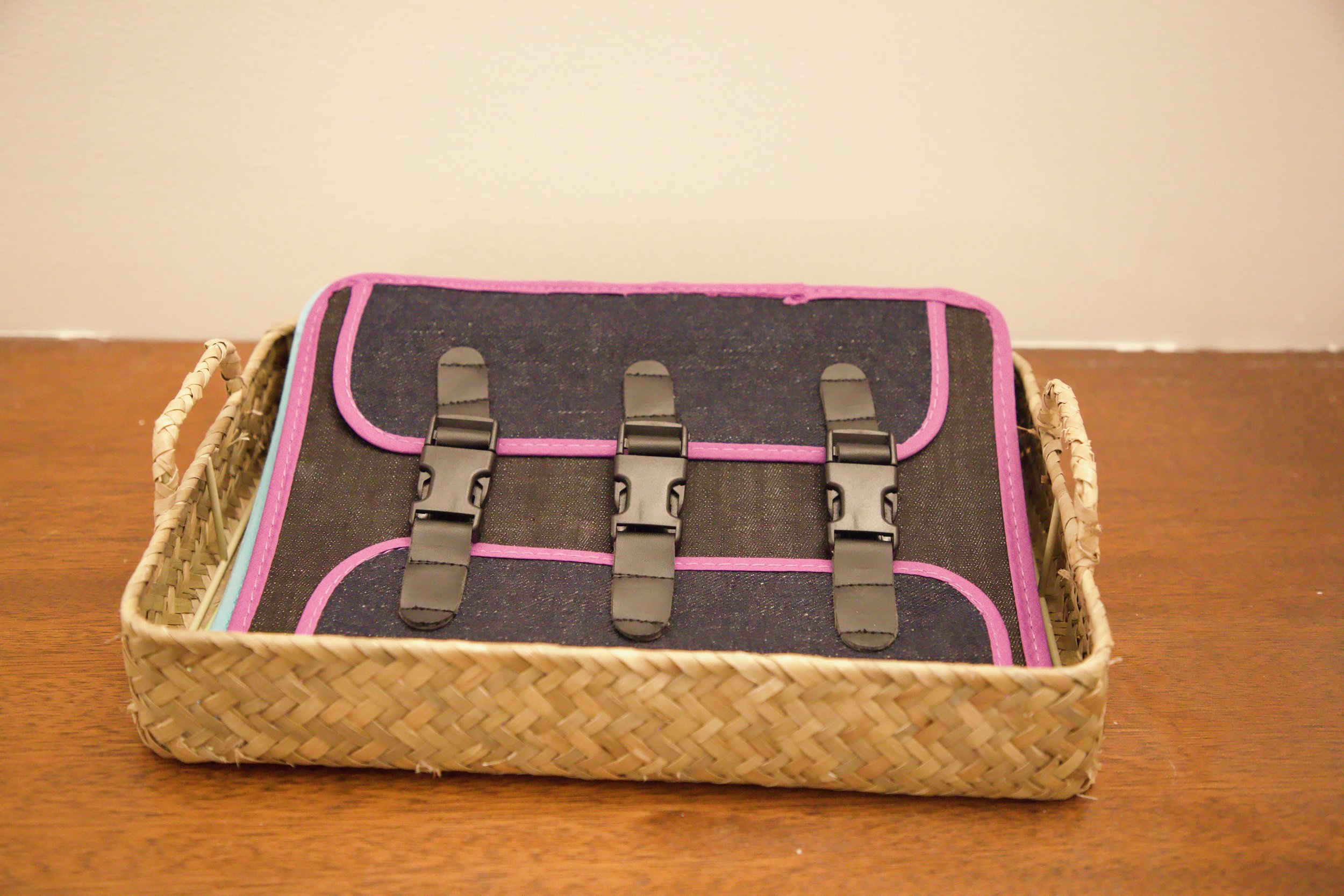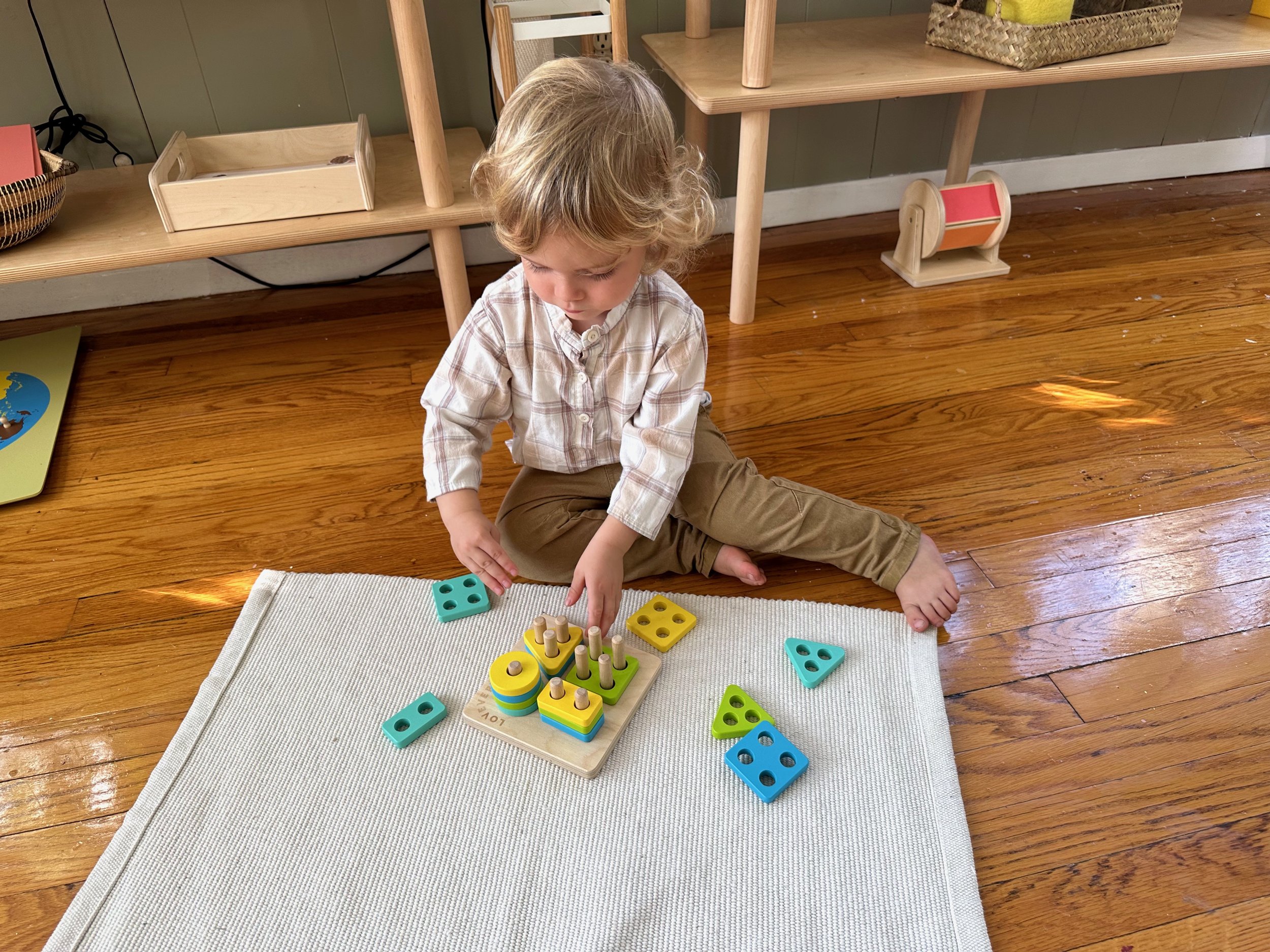Montessori Toddler Activities: Shelfwork 24-30 Months
This post may contain affiliate links, which means I may earn a small commission if you buy through my link but does not change your price.
I am asked a lot for ideas for Montessori homeschooling for toddlers or just Montessori activities for toddlers. I used to share a monthly and then every few months blog and Youtube but I did not get to it for these months. At this point, I want to get the blog out because my son is nearing 3 and I will want a whole new blog post then! In the period from 24-30 months (2-2.5) shelf work was not a huge part of our day. During this period we moved and also went on a 2.5-month trip. It was also summer which I won’t be surprised in general if is more about being outside for us than shelf work. I started more of a Montessori “homeschool” routine (he’s 2… it’s not really homeschool) near the end of this period so quite a few of the activities featured were done when he was closer to 2.5. That said, we did have some wonderful Montessori shelf work both soon after turning two and as he approached 2.5 I will be sharing in this blog post.
Quite a few of these activities can be done as DIYs or with objects you have at home to make it easier and require less purchasing. During this period he was starting to get more interested in open-ended toys as well which, when you are able to DIY the close-ended ones, might make more sense for investing in.
A note on language: in Montessori toys are called “materials” and play is called “work.” Shelfwork refers to the materials displayed on a shelf for a child to choose. These are generally close-ended materials meaning they have a specific purpose. We also play with plenty of open-ended toys in our home. However, these are not the focus of this post since this post is about our Montessori works. It does, however, include a few off-the-shelf activities in the practical life section.
Language
Language activities are my son’s favorite. He is very much in the sensitive period for language and loves learning new words all the time. As such, this is a large part of our shelfwork.
Matching Activities
Matching activities were a favorite in this period. My son started picture-to-object matching at around 18 months. By 24 months we were doing more complex matching activities. Matching activities are a wonderful way to add more language using the three-period lesson. While early matching activities are best done with exact picture-to-object matches, once those are mastered you can switch to ones where the photo does not exactly match the object. You can do any sort of object-to-picture matching. I have made a variety of cards to go with Safari Ltd. Toobs. Once he begins to lose interest in one of the matching activities, I will rotate it out and then rotate it back in a few months later. This gives him a refresher of the vocabulary.
These world landmarks, for example, were a favorite matching activity from around 21 months. He still loved them at 30 months, however. These are more challenging since they feature the landmark in context. They also introduce more challenging vocabulary. Hearing a two year old say “Taj Mahal” is a highlight for me.
Another favorite during this period was bird matching. This again introduces some diverse language.
Here I added chopsticks to the matching activity to make it more interesting for Y. He was working on chopsticks and this was a great way to work on that fine motor work while also doing a favorite activity. These cards are available here but please note I made some changes to be more Montessori-aligned with real photos after producing the ones pictured here.
After object-to-picture matching you have the opportunity to introduce picture-to-picture matching and then more complex matching such as picture-to-shadow. Many children will still be more drawn to object-to-picture matching but this is an easy way to offer more language opportunities and matching activities.
Letter Sorting
When it comes to letters, something to keep in mind is they are ultimately shapes. My son was interested in letters so we began by introducing them the same way we would introduce other shapes. This came as we neared 2.5. I introduced letter matching and then letter sorting. The first, letter matching, involved one-to-one correspondence of one letter to one letter. We used the sandpaper letters along with other lowercase letters we found around.
Next, I printed more small letters and we sorted small print-out letters into our sandpaper letters. My son was not interested in tracing the sandpaper letters at all, but that’s okay! We just used them for letter sorting. We introduced three letters at a time.
Letter Puzzles
These letter puzzles were another part of our language learning as he neared 2.5. What I love about these is that they have an item with the letter on the puzzle and both upper and lowercase. The puzzle part itself was easy for him but we used this as another opportunity to work on letter sounds and identify the sounds in the words pictured.
Initial Sound Games
This activity was not actually on the shelf but it is an important language activity for me to mention. We worked on isolating the first sounds in words. This worked in two ways. Sometimes I would ask him if he could identify the beginning sound in a word, slowly saying the word with a bit of space in between the initial sound and the rest of the word. Other times I would use first letters to jog his memory or allow him to guess. For example, say he asked what we were having for dinner. I would say “we’re having /c/” and he would guess “curry!” This phonological awareness is a pre-reading skill.
Clapping Syllables
For this activity, we would look at photos of objects. He would identify the object and then we would clap the number of syllables. You can also use maracas for this or another music-making toy. We would often use first word books to find words to clap. This is a pre-reading skill, allowing children to break down words.
Sensorial
Sensorial refers to the activities that refine a child’s senses. In our home, much of this is more done through practical life than with traditional Montessori sensorial materials. That said, we had some sensorial learning on the shelf during this period.
Color Matching
My son’s favorite sensorial activity by far during this time was color matching. He did multiple different color-matching and color-sorting activities. Similar to object to picture matching, he mastered this at around 18 months. During this period (24-30 months), however, he still really enjoyed working on color discrimination so I introduced a lot of materials around color sorting. The general trajectory of color sorting is from one-to-one correspondence (matching) to sorting exact objects to sorting a variety of objects. At this point, most of the color sorting we do is a variety of objects. We also generally add in tongs or other tools to increase the challenge.
This color-matching activity uses one-to-one correspondence. However, he enjoyed the tongs as more of a challenge. It also was chosen for the shelf in the fall since we were learning a bit about bees and honey at the time.
This is another color-sorting activity. It also uses tongs to practice fine motor work. This one has multiple objects per color rather than one-to-one correspondence. Though I have this under sensorial, in many ways, it is math too. We would count the number of pieces as he put them in.
This is an example of a more challenging color sorting activity as it involves pictures (more abstract) and real objects that are not as strictly speaking one color. This was still very simple for him at the time though. This was introduced near the end of the 24-30 month period and he was no longer particularly interested in straightforward color sorting. By this time adding tools like the tongs was necessary to keep his interest.
Color sorting can take all sorts of forms and this was another activity he enjoyed during this period, particularly near the early end of it.
Color Mixing
This was a really fun activity we did as a sort of science experiment but we kept out after. Mix oil-soluble food coloring with baby oil and water-soluble food coloring with water. Combine and you have color mixing jars. They combine to the mixed color when you shake them and separate if you leave them.
Size Sorting
Another sort of sensorial activity we did during this period was size sorting with apples. This is a more challenging activity than color sorting for most children but is a great one during this time. We would sort into groups of big and small or big medium and small. We loved this set of apples for size sorting in the fall but it can be done with rocks or any sort of thing you have in different sizes.
Practical Life
Practical life really is the center of our home. In Montessori, practical life is the focus of the early years and I think that is often even more true at home. Life is practical life and my toddler would much rather cook or clean with me than go off to play on his own. We are doing practical life all day: cooking, emptying the dishwasher, tidying, laundry, setting the table.. but these are some particular practical life favorites in our home from 2-2.5 years old.
Cooking
I think cooking has taken the cake as the favorite activity since my son just turned 1 and that hasn’t changed this time. My son loves to cook with me and to lead his own cooking using his visual recipes. These are from my book and cook guide which we used to pair books with recipes. This was an absolute favorite activity this month. It isn’t shelfwork per say but it is an important part of how Montessori looks in our home.
Flower Arranging
Flower arranging is a wonderful Montessori activity during this age range. It works on pouring with precision, fine motor work of arranging the flowers, and care as to not crush the flowers. It is also a wonderful way to beautify the environment.
Pouring to the Line
During this period my son mastered moving from pouring out the entire pitcher to pouring to the line. This means he will pour from a container with more water and stop once he has reached the line. Before this period, he would dump the entire pitcher, regardless of how much was in it and if it overflowed. This activity is wonderful for developing self-control and hand-eye coordination. All you need is a container with a line (I use painter’s tape) and a pitcher with more water than would reach the line.
Beading
Most of our practical life activities are in context in everyday life but beading is a wonderful practical life activity on the shelf. This beading activity was soon after he turned 2. In this period you can introduce different levels of challenge with beading as well as threading activities.
Dressing Frames
Dressing frames are another one of the few Montessori practical life activities that are really taken out of the context of actual everyday life. This is because these skills are so much more challenging to develop while on. My son worked on some of the more simple dressing frames during this period: snaps, buckles, and the zipper with my help starting it. We bought these dressing frames while in South Korea but here is a link to the classic Montessori ones and here is a link to a more budget version.
Puzzles
I have a whole blog series on our puzzle progression, but puzzles were a favorite during this period. They don’t fit easily in any of the other Montessori curriculum areas, so I am giving them their own section. Please note, I am sharing the puzzles my son was interested in during this period. There is a wide variety of interests and abilities. He is particularly talented at puzzles.
Inset Puzzles
By 2, Y no longer had as much interest in inset puzzles, but he still loved this elephant size-discrimination one near the beginning of this time period. This blog post goes into more about what to expect with inset puzzle progression. These work on hand-eye coordination and fine motor skills.
3-Piece Animal Puzzles
These are a great starter puzzle for a 2-year-old. He loved these around when he turned 2. He had outgrown the mom and baby matching puzzles at this point. These are great for introducing jigsaw puzzles and can grow with your child as you add more of the puzzles. At first, we started with only a few of the puzzles but, after a few days, he was mixing them all up.
Progressive Puzzles
These are another great option for introducing jigsaw puzzles to a 2-year-old (exact ones no longer available). However, since we outgrew them Skillmatics introduced these (Ayelet20 for discount) and I like that they use real photos, which are more Montessori-aligned. Progressive puzzles are good for slowly building up puzzle skills.
Larger Jigsaws
Once he mastered the progressive puzzles we did lots of larger jigsaws. The Skillmatics construction piece and play (Ayelet20 gives a discount) was his favorite.
Sort and Stack Peg Puzzle
This is a bit of a different type of puzzle (and probably could be included under a different section of this post as well). I saw my son develop math and spatial reasoning skills by doing this puzzle.
That’s it, that’s a look at the shelfwork we did from 2-2.5. Of course, some other things didn’t make it onto this list, however, this is a lot of the shelfwork we did during this period. Hopefully, it gives some ideas of Montessori activities for a 2-2.5-year-old! This is a wide variety of ages and children vary so much in ability and interest during this period. My goal of this post is to serve as a guide of some things you may want to introduce rather than a set curriculum.







